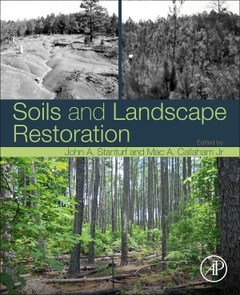Description
Soils and Landscape Restoration
Coordinators: Stanturf John A., Callaham Mac A.
Language: English
Subjects for Soils and Landscape Restoration:
Keywords
Acidification; Assisted migration; Biodiversity; Biodiversity loss; Bonn challenge; Charcoal; Climate; Climate change; Contamination; Deforestation; Desertification; Ecosystem engineer; Ecosystem legacy; Ecosystem restoration; Ecosystem services; Edaphic characteristics; Environmental education; Fertility; Field experiment; Fire; Fire classification; Forests; Fossorial bird; Fossorial mammal; Fossorial reptile; Grasslands; Grazing; Harvest operations; Heathlands; Herbage addition; Inoculation; Irrigation; LDN; Landfills; Loss of productivity potential; Mine reclamation; Mining; Monitoring; Mycorrhiza; Mycorrhizae; Novel soil ecosystems; Nutrient; Nutrient cycling; Phyto-recurrent selection; Phytoremediation; Plant productivity; Plant selection; Plant translocation; Prescribed fire; Pyrolysis; Reclamation; Reforestation; Rehabilitation; Restoration; Rhizosphere; Riparian buffer systems; Risks; Salinity; Severity; Short rotation woody crops; Site preparation; Socioecological systems; Soil; Soil amendments; Soil degradation; Soil erosion; Soil fauna; Soil function; Soil health; Soil invertebrate; Soil macroinvertebrate; Soil mesoinvertebrate; Soil microinvertebrate; Soil organic matter; Soil pathogen; Soil structure; Soils; State factors; Sustainable management; Terra preta; Topsoil removal; Urban afforestation; Urban cultural landscapes; Urban soil restoration; Wildfire
440 p. · 19x23.3 cm · Paperback
Description
/li>Contents
/li>Readership
/li>Biography
/li>Comment
/li>
1. Soils are Fundamental to Landscape Restoration 2. Soil Ecology and Restoration Science 3. Sustaining Forest Soil Quality and Productivity 4. Sustainable Management of Grassland Soils 5. Landscape Degradation and Restoration 6. Soil Recovery and Reclamation of Mined Lands 7. Salinity and the Reclamation of Salinized Lands 8. Biochar for the restoration and rehabilitation of managed systems 9. Bioremediation and Soils 10. Adaptive management of landscapes for climate change: How soils influence the assisted migration of plants 11. Soils and Restoration of Forested Landscapes 12. Restoring Fire to Forests: Contrasting the Effects on Soils of Prescribed Fire and Wildfire; 13. Converting Agricultural Lands into Heathlands: The Relevance of Soil Processes 14. Socioecological Soil Restoration in Urban Cultural Landscapes
Restoration practitioners at all levels; soil scientists, forest, landscape, and soil ecologists; land managers
Mac Callaham is a Research Ecologist with the USDA Forest Service’s Southern Research Station in Athens, Georgia. He has 25 years’ experience of working in soil ecology with projects ranging from agroecology to ecotoxicology to grassland and forest restoration and management. Following graduate school at Kansas State University, he held post-doctoral positions at Oak Ridge National Laboratory (2000-01), and with the USDA Forest Service at Clemson University (2001-03). In 2005, Callaham became a Team Leader within the Center for Forest Disturbance Science, a unit of the Forest Service’s Southern Research Station
In 2005, Callaham was awarded the Southern Research Station Director’s Award for Early Career Scientists. Having long been interested in international research, Callaham was awarded a Fulbright Scholarship in 2010 to participate in research in southern Brazil with a focus on restoration of Atlantic rai
- Incudes a chapter on climate change and novel ecosystems, thus collating the perspective of soil scientists and ecologists on this consequential and controversial topic
- Connects science to international policy and practice
- Includes summaries at the end of each chapter to elucidate principles and key points



